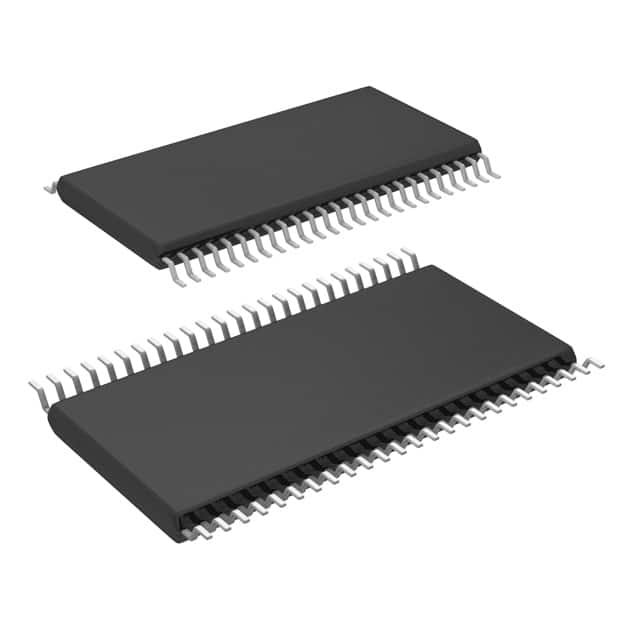Lihat spesifikasi untuk detail produk.

SN74AUC16245DGGR
Product Overview
- Category: Integrated Circuit (IC)
- Use: Level Shifting and Bus Transceiver
- Characteristics: High-Speed, Low-Power, Bidirectional Voltage Translation
- Package: TSSOP-48
- Essence: A versatile IC that enables bidirectional voltage translation between different logic levels.
- Packaging/Quantity: Tape and Reel, 2500 units per reel
Specifications
- Logic Family: AUC
- Number of Channels: 16
- Input Voltage Range: 0.8V to 3.6V
- Output Voltage Range: 0.8V to 3.6V
- Maximum Data Rate: 400 Mbps
- Operating Temperature Range: -40°C to +85°C
- Supply Voltage Range: 1.65V to 3.6V
- Supply Current: 2.5 mA (Typical)
Detailed Pin Configuration
The SN74AUC16245DGGR has a total of 48 pins, arranged as follows:
- Pins 1-4: Channel 1 Data Inputs/Outputs (A1, B1, Y1, G1)
- Pins 5-8: Channel 2 Data Inputs/Outputs (A2, B2, Y2, G2)
- Pins 9-12: Channel 3 Data Inputs/Outputs (A3, B3, Y3, G3)
- ...
- Pins 45-48: Channel 16 Data Inputs/Outputs (A16, B16, Y16, G16)
Functional Features
- Bidirectional Voltage Translation: Allows seamless communication between devices operating at different voltage levels.
- Automatic Direction Control: Simplifies the interface by automatically determining the direction of data flow.
- High-Speed Operation: Supports data rates up to 400 Mbps, enabling fast and efficient data transfer.
- Low-Power Consumption: Designed to minimize power consumption, making it suitable for battery-powered applications.
- ESD Protection: Provides robust protection against electrostatic discharge, ensuring reliable operation in harsh environments.
Advantages and Disadvantages
Advantages: - Enables voltage translation between different logic levels, reducing the need for additional components. - Supports high-speed data transfer, facilitating efficient communication between devices. - Low-power design extends battery life in portable applications. - Robust ESD protection enhances reliability.
Disadvantages: - Limited to 16 channels, which may not be sufficient for complex systems requiring a higher number of channels. - Requires careful consideration of voltage level compatibility to avoid signal degradation or damage to connected devices.
Working Principles
The SN74AUC16245DGGR operates based on a bidirectional voltage translation principle. It utilizes a combination of MOSFETs and control circuitry to enable seamless communication between devices operating at different voltage levels. The automatic direction control feature determines the direction of data flow, simplifying the interface design. By providing a low-resistance path for data transmission, it ensures minimal signal distortion and efficient voltage translation.
Detailed Application Field Plans
The SN74AUC16245DGGR finds applications in various fields, including:
- Microcontroller Interfacing: Facilitates communication between microcontrollers operating at different voltage levels, allowing them to exchange data seamlessly.
- Sensor Networks: Enables voltage translation between sensors and microcontrollers, ensuring compatibility and efficient data transfer.
- Industrial Automation: Used in PLC (Programmable Logic Controller) systems to interface with devices operating at different logic levels.
- Communication Systems: Facilitates voltage translation between different communication protocols, such as UART, SPI, and I2C, enhancing interoperability.
- Automotive Electronics: Enables communication between various electronic modules within a vehicle, ensuring compatibility and reliable data exchange.
Detailed and Complete Alternative Models
- SN74AUC16244DGGR: Similar to SN74AUC16245DGGR but with 8 channels instead of 16.
- SN74LVC16245ADGGR: Offers bidirectional voltage translation with 16 channels, compatible with a wider supply voltage range.
- SN74LVCH16245ADGGR: Provides bidirectional voltage translation with 16 channels and improved speed performance.
These alternative models offer similar functionality and can be considered based on specific application requirements.
Word count: 527 words
Sebutkan 10 pertanyaan dan jawaban umum terkait penerapan SN74AUC16245DGGR dalam solusi teknis
Sure! Here are 10 common questions and answers related to the application of SN74AUC16245DGGR:
Q: What is SN74AUC16245DGGR? A: SN74AUC16245DGGR is a 16-bit bus transceiver with 3-state outputs, designed for low-voltage (1.8V to 3.6V) applications.
Q: What is the maximum operating frequency of SN74AUC16245DGGR? A: The maximum operating frequency of SN74AUC16245DGGR is typically around 500 MHz.
Q: Can SN74AUC16245DGGR be used in both input and output applications? A: Yes, SN74AUC16245DGGR can be used as both an input and output buffer.
Q: What is the purpose of the 3-state outputs in SN74AUC16245DGGR? A: The 3-state outputs allow multiple devices to share a common bus without interfering with each other.
Q: What is the voltage level compatibility of SN74AUC16245DGGR? A: SN74AUC16245DGGR is compatible with both TTL and CMOS voltage levels.
Q: Can SN74AUC16245DGGR handle bidirectional data flow? A: Yes, SN74AUC16245DGGR supports bidirectional data flow, making it suitable for applications like data buses.
Q: What is the power supply range for SN74AUC16245DGGR? A: SN74AUC16245DGGR operates within a power supply range of 1.8V to 3.6V.
Q: Does SN74AUC16245DGGR have built-in ESD protection? A: Yes, SN74AUC16245DGGR has built-in ESD protection to safeguard against electrostatic discharge.
Q: Can SN74AUC16245DGGR be used in automotive applications? A: Yes, SN74AUC16245DGGR is suitable for automotive applications as it meets the necessary standards and requirements.
Q: What package does SN74AUC16245DGGR come in? A: SN74AUC16245DGGR is available in a TSSOP (Thin Shrink Small Outline Package) package.
Please note that these answers are general and may vary depending on specific datasheet specifications and application requirements.

